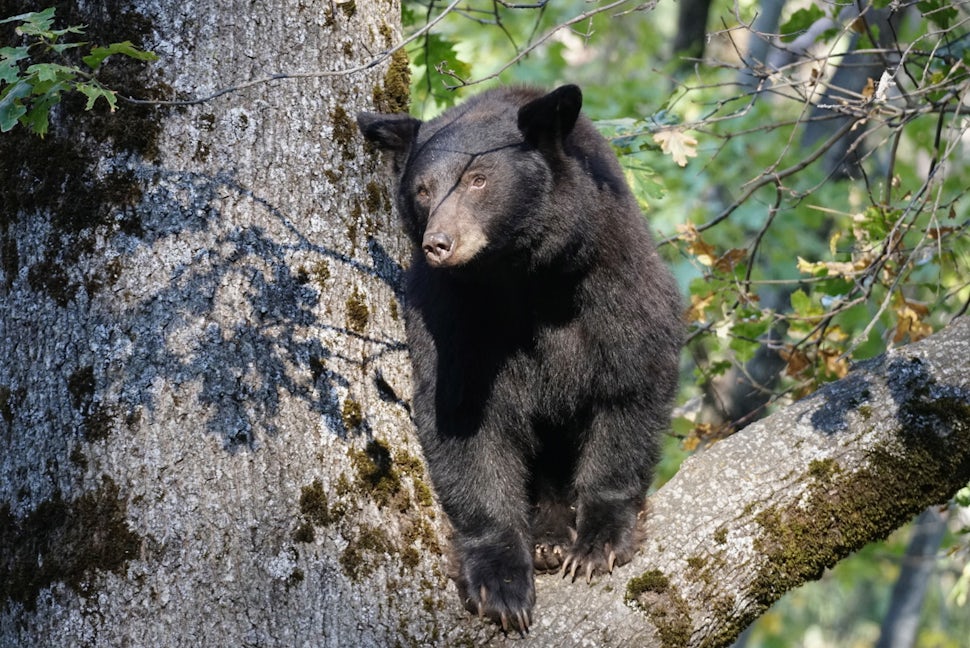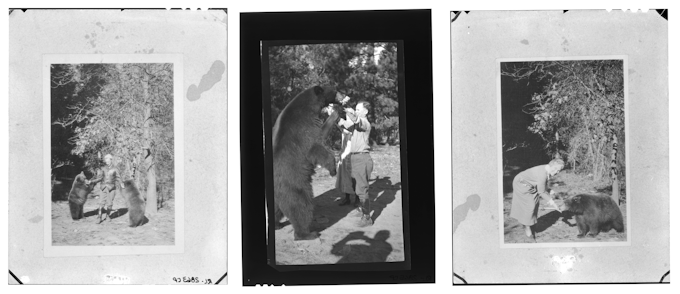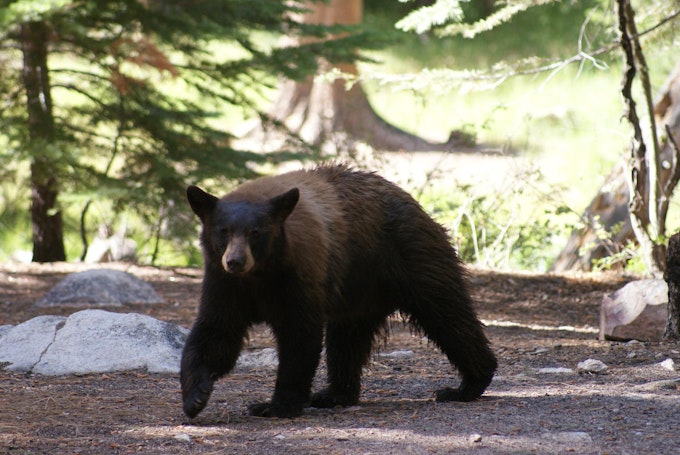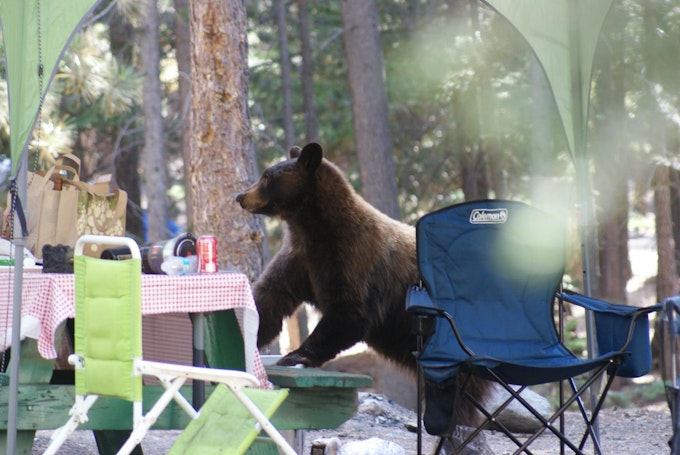Who is keeping Yosemite bears wild? And how?

There are anywhere from 250 to 550 American Black Bears that call Yosemite National Park home. These bears live throughout the park wilderness and cohabitate in areas populated by visitors and employees.
Yosemite’s Bear Team works to keep bears wild. I spoke to three bear team members; Caitlin Lee-Roney, lead of the wildlife management and human-bear management programs; Robert Lester, biological science technician, and Scott Gediman, public affairs officer. From these conversations, I will share facts about Yosemite bears, how to keep wildlife wild, who is working to protect them, and what you should do when recreating in black bear country.
4 Bear facts & lingo

1. Black bears vary in color
You will see an array of hues when viewing bears in Yosemite. Black bears can be anything from black to brown to cinnamon to blonde. There are no grizzly bears (AKA brown bears) in Yosemite National Park or the state of California, despite the state flag featuring one. The last known grizzly in California was killed in the 1920s.
2. Hibernation isn’t a 4-month nap
I’ll let Robert explain it a bit more: “Bears go into a state of torpor, which means they have a lowered metabolism. They're not true hibernators, like ground squirrels and other smaller animals, who do shut down. [They create a den which can] be in root masses or caves, under boulders, but commonly in the bases of hollowed-out trees. They don't eat or drink while they're in the den and develop a rectal plug that prevents any defecation or urination.” Basically, their body recycles, or metabolically extracts, energy from their waste, which allows them to come out of the den ready to find food, rather than emaciated after a long nap.
3. Bears are extremely intelligent and curious
Caitlin says her favorite thing about bears is watching them outsmart people. “Even though it's the most stressful thing, watching them outsmart [humans] is incredible, and just seeing what they're capable of, even if you know it isn’t always better for them.”
4. Bears become habituated when they regularly interact with people
Bears are naturally afraid of humans, so they will do their best to not get close. However, Caitlin explains, “As they see people more and more, [if] they realize there's no negative consequence happening, they're going to get more and more comfortable with people getting closer and closer.” This is why it is important to give bears space. Bears in repeated contact with humans are at risk of becoming nuisance bears, animals who have lost their fear of people.
History of bear management

The National Park Service hasn’t always managed human-bear interactions. There was a time in the early 1900s when the large mammals were seen as entertainment at the park. The concessionaire would dump garbage for the bears to come to pick through while spectators watched from bleachers. Park visitors would even feed the bears by hand.
The bears learned to be food conditioned and habituated. Caitlin explained that a bear becomes food-conditioned when they can regularly get human food, which changes the bears’ brain chemistry to realize there is a higher caloric option available than their natural food sources. “Like, if they get a candy bar once they realize, ‘wow, this is like a supercharged food source.’”

Scott and Caitlin shared that in the peak of bear incidents in the late 90s, there were approximately 1600 incidents within Yosemite, in only a year. This works out to an average of 4.4 incidents per day. Caitlin was volunteering in Yosemite at the time and said “You'd be chasing one [bear] and you'd run into another one. You could just literally chase bears for hours on end and they'd be breaking into cars, getting into the trash, getting into lockers, finding backpacks out.” Scott said there was a security guard in the Curry Village parking lot whose sole purpose was to chase away bears who were breaking into cars.
After an incident where a young bear was killed by a group of Boy Scouts in Yosemite, news shows started coming out to the park to do stories on the bear issue. Scott spoke to numerous networks about the bears who had learned there was easy food availability where people congregate.
National Geographic came to see the issue and talk with Scott and the women who spoke with him got an idea. Her husband was the chief of staff for a congressman and together with Scott, they spoke to the congressman about this issue. He was able to help get $500,000 for the park each year to help facilitate bear education in hopes of decreasing the number of bear-human incidents.
The creation of the Bear Team

After receiving funding in 1999, Yosemite National Park created the Bear Team, an inter-divisional group of National Park Service employees, concessions staff, and park partners focused on keeping bears wild and educating the public. Caitlin shares that the Bear Team “came about because wildlife management alone cannot fix this bear problem. We can't keep bears wild just with the few people we have, so it was that realization that we can't do it without [support of other divisions].”
More than 20 years later, the Bear Team still exists in Yosemite with the same common goal of keeping bears wild. There are not nearly as many incidents as before, but there is still bear-human conflict that occurs every year, from car break-ins to cooler smuggling.
The wildlife management members of Bear Team interact with only a handful of the population, mainly focusing on bears who are going into visitor areas and looking for unnatural food sources. Other employees of the Bear Team range from campground rangers helping out with food storage education and compliance to interpretive rangers patrolling in the evenings for bears who are trying to be creative with their food sources.
You can see more about the bear incidents in 2022 here.
Tips for recreating in bear country
When you recreate where bears live, you are entering their home. Bears who no longer fear humans, or become food-motivated breaking into homes or campsites, will often be euthanized if the behavior continues. Following the rules below makes you a part of the “bear team” to help keep these awesome creatures wild.
1. Store food (and anything that smells) properly

Read up on food storage regulations where you are recreating. Use provided food lockers, keep your area clean, and treat your toiletries and trash as “food.” Check out this video about proper food storage. If you are planning on backpacking, there are strict storage guidelines for backcountry adventures as well.
2. Follow posted speed limits
Have you ever seen signage with a red bear on it? The “red bear-dead bear” signage is located where car collisions with bears have occurred. Each year, approximately a dozen bears are maimed or killed by vehicles. Speeding can lead to unnecessary deaths or injury of bears and other animals. The park has posted speed limits to protect the animals who call Yosemite home.
Caitlin says, “Be ready to slam on your brakes at any given time for an animal that suddenly darts in front of you. It's probably the biggest source of mortality in the park for a lot of different species of wildlife and that is 100% human-driven.” Slow down, enjoy the views, and keep your eyes ahead to avoid unnecessary harm to wildlife.
3. Wildlife is wild, give bears space
Give bears a berth of at least 50 yards. Enjoy getting to see a bear but give it the space and respect it deserves.
4. Habituated bears often end up dead
When you cross paths with a bear in a developed area (i.e. campground, parking lot, lodge, etc), you should make the bear uncomfortable, so they see humans as a threat. This prevents habituation. The Yosemite website recommends “Scare the bear away by yelling aggressively and as loudly as possible until the bear leaves. If the bear is intruding on your personal space: act angry and be persistent. If you are with other people, stand together to present a more intimidating figure, but do not surround the bear.” Do not run. Hold your ground and make yourself big.
If you see a bear in an undeveloped area that is not approaching people, give it space (50 yards). Taking these steps around bears will reduce the likelihood of them becoming comfortable around humans and avoid them being put down.
5. No bear spray necessary

Bear spray (and pepper spray) is considered a weapon in Yosemite. While there is science behind bear spray working well on grizzlies, there is no science showing it works for black bears. Spray often impacts humans more than bears as it requires precise timing, practiced application, and appropriate wind direction.
Caitlin says that bears naturally “avoid conflict.” They are not predatory and will not attack first. If they do attack, you should fight back. However, black bears can become predatory if you get between a mother with cubs or if you are too close and they feel threatened. They are known to bluff charge as a scare tactic, where they "bound on [their] front paws toward you (moving in big leaps), but then stop short or veer off to one side."
6. Take a step back from social media
Robert shares that “getting that Instagram photo, [selfie], or whatever photo is detrimental to the future of wildlife because we're just creating so much conflict [due to] people approaching wildlife. Whether it's bison in Yellowstone, grizzly bears or black bears, or deer. People are just trying to take selfies and use drones and it really disturbs and harms wildlife.”
7. If you see a bear (or bear attractant), let a ranger know
You can be a part of the Bear Team by calling 209-379-0322 or finding a ranger to report a bear sighting, overflowing trash/recycle containers, or improperly stored food.
Interested in learning more? Check out the Bear Team Blog, Keep Bears Wild website or watch Nature Notes: Black Bears. You can even follow collared Yosemite Bears with the Bear Tracker!
Thank you to Bear Team Members Caitlin, Robert, and Scott for sharing their experiences and knowledge. An additional thank you to Robert for his photographic contributions to this story, including the feature photo. Follow him on Instagram @yosbear.
We want to acknowledge and thank the past, present, and future generations of all Native Nations and Indigenous Peoples whose ancestral lands we travel, explore, and play on. Always practice Leave No Trace ethics on your adventures and follow local regulations. Please explore responsibly!
Do you love the outdoors?
Yep, us too. That's why we send you the best local adventures, stories, and expert advice, right to your inbox.








